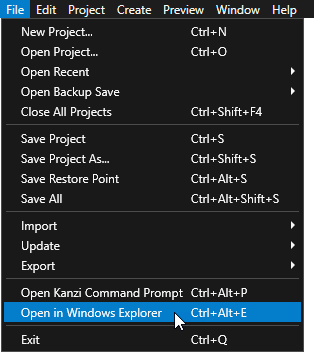For example, if you have a locale pack for the Japanese, Chinese and Korean locales, and used ja-JP locale name for the Japanese locale, zh-ZH for the Chinese locale, ko-KR for the Korean, create the binaries.cfg, open it in a text editor, add the names of these locale pack files to the binaries.cfg file, and save the file.
ja-JP ko-KR zh-ZH
If you open the tutorial solution in Visual Studio 2017, when asked to retarget the project to the latest Microsoft toolset, click Cancel.
To open the directory of a Kanzi Studio project from Kanzi Studio, select > Open in Windows Explorer.
DynamicPropertyType and use the same name that is used in the Kanzi Studio project.class LocalizationApplication : public ExampleApplication
{
// Type of the shared pointer for the custom property type defined
// in the Kanzi Studio project.
typedef shared_ptr<DynamicPropertyType<string> > StringDynamicPropertyTypeSharedPtr;LocalizationApplication class in the onProjectLoaded function implement the event handler that loads the resources for the locale pack kzb files stored in the Locale_packs directory, and adds the locales to the project.
// Set the name of the directory where you stored the locale packs.
static const string localizationFolderName = "Locale_packs";
// Get the Screen node in the kzb file. You use the Screen node to access all the other nodes and resources in the kzb file.
ScreenSharedPtr screen = getScreen();
// Domain is a collection of all subsystems and contains the Kanzi resource manager. You need to get the resource manager to access the resources in the kzb file.
ResourceManager* resourceManager = getDomain()->getResourceManager();
// Get the LocaleSelector node which contains the locale selection buttons.
// Access alias target nodes using the # sign followed by the name of the alias.
Node2DSharedPtr localeSelector = screen->lookupNode<Node2D>("#LocaleSelector");
// Get the LocaleButton prefabricated template used for the buttons that set the locale.
// Get the reference to the template using the kzb URL.
// When you use the full path of a resource, start the path with kzb:// followed by the project name and the location of the resource.
PrefabTemplateSharedPtr localeButtonPrefab = resourceManager->acquireResource<PrefabTemplate>("kzb://localization/Prefabs/LocaleButton");
// Get the custom property type for setting the name of the locale in the
// LocaleButton node. You created this custom property type in the Kanzi Studio project.
StringDynamicPropertyTypeSharedPtr localeNameProperty = StringDynamicPropertyTypeSharedPtr(new DynamicPropertyType<string>("Localization.LocaleName"));
// Get the custom property type for setting the locale in the application.
// You created this custom property type in the Kanzi Studio project.
StringDynamicPropertyTypeSharedPtr localeIdProperty = StringDynamicPropertyTypeSharedPtr(new DynamicPropertyType<string>("Localization.LocaleID"));
// Read the binaries.cfg file that contains the list of the kzb files
// that contain the locale packs.
string configFileName = localizationFolderName + "/binaries.cfg";
ReadOnlyDiskFile binariesConfigFile(configFileName);
string binariesConfigContents = readAsText(binariesConfigFile);
stringstream binariesConfigFileStream(binariesConfigContents);
string localeId;
// Load the resources stored in the locale pack kzb files.
while (getline(binariesConfigFileStream, localeId))
{
trim(localeId);
// Create the path for the kzb file.
string localizationKzbFilePath = localizationFolderName + "/" + localeId + ".kzb";
// Add the kzb file to the Kanzi resource manager.
getResourceManager()->addKzbFile(localizationKzbFilePath);
string dictionaryUrl = "kzb://localization/Locales/" + localeId;
ResourceDictionarySharedPtr localeDictionary = getResourceManager()->acquireResource<ResourceDictionary>(dictionaryUrl);
// Instantiate the LocaleButton prefab.
Node2DSharedPtr localeButton = localeButtonPrefab->instantiate<Node2D>("LocaleButton_" + localeId);
// Get the name of the locale that is shown in the application from the
// resource ID LocaleDisplayName stored in the localization table in the locale pack.
TextResourceSharedPtr localeDisplayNameResource = localeDictionary->acquire<TextResource>(ResourceID("LocaleDisplayName"));
// Set the LocaleName property so that the Text Block 2D node in the button shows the name of the locale.
localeButton->setProperty(*localeNameProperty, localeDisplayNameResource->getText());
// Set the LocaleID property so that when you click the button the application changes to that locale.
localeButton->setProperty(*localeIdProperty, localeId);
// Set the style of the Text Block 2D node in the button so that it sets
// the correct font for the LocaleDisplayName of the locale.
// Use this approach only to apply a style from the locale pack without changing the locale
// in the application.
optional<string> localeStyle = localeDictionary->find(ResourceID("LocaleStyle"));
StyleSharedPtr style = getResourceManager()->acquireResource<Style>(*localeStyle);
localeButton->setStyle(style);
// Add the LocaleButton node to the LocaleSelector node.
localeSelector->addChild(localeButton);
}
For example, if you are still developing your application, select the GL_vs2015_Debug configuration. If you want to create a production version of your Kanzi application, select one of the available release configurations.

